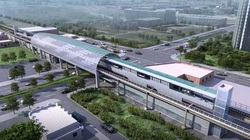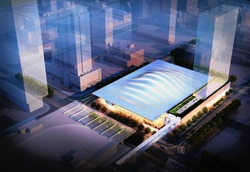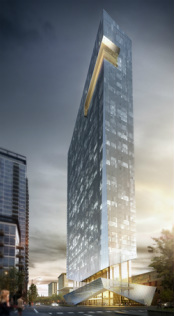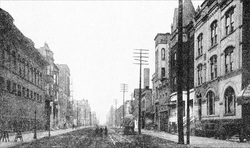
The Levee is a former red-light district in Chicago, Illinois, located near the intersection of Cermak Road and Michigan Avenue in the city's Near South Side. It consisted of twenty square blocks in which:
"There were said to be 500 saloons, 500 whorehouses, 56 pool rooms, 15 gambling halls, and too many peep shows and cocaine parlors and bawdy theaters to count. All of it was overseen by a flamboyant saloon keeper and Democratic committeeman, Mike "Hinky Dink" Kenna.
It was formed in 1893, during the World's Columbian Exposition, but by 1930 the district had largely been demolished. (Wikipedia)
"There were said to be 500 saloons, 500 whorehouses, 56 pool rooms, 15 gambling halls, and too many peep shows and cocaine parlors and bawdy theaters to count. All of it was overseen by a flamboyant saloon keeper and Democratic committeeman, Mike "Hinky Dink" Kenna.
It was formed in 1893, during the World's Columbian Exposition, but by 1930 the district had largely been demolished. (Wikipedia)

Michael "Hinky Dink" Kenna (August 20, 1858–October 9, 1946) was one of the two aldermen elected in Chicago's First Ward, from 1897 to 1923
At age 10, Kenna left school and began selling newspapers. By age 12, he had borrowed $50 from a barkeeper and purchased a newsstand at the corner of Monroe Street and Dearborn Street. He was so successful that he was able to pay back the loan within a month. According to legend, it was at this time that Kenna got his nickname from Chicago Tribune publisher Joseph Medill, because of his small stature. Even as an adult, Kenna stood just 5 foot 1 inch tall.
In addition to being an alderman, Kenna ran a saloon, The Workingman's Exchange, located on Clark Street. Kenna doled out meals to the indigent in exchange for votes.
Kenna and his partner, fellow First Ward alderman "Bathhouse" John Coughlin, were known as the "Lords of the Levee", a district included in their ward which provided them with the support of prostitutes, pimps, tavern-owners and gamblers.
Coughlin and Kenna were also known for hosting the First Ward Ball, an annual fundraiser which brought together gangsters, safecrackers, prostitutes, politicians, businessmen, gamblers, and other types as well. The event raised more than $50,000 a year for the two men until it was closed down in 1909 by Mayor Fred Busse. By the time it was banned, the ball was so large that it had to be held in the Chicago Coliseum, the city's major convention center. Besides its notoriety in attracting many unsavory characters it often ended with the police having to curb disorderly conduct bordering on rioting.
In 1923, the number of aldermen per ward was lowered from two to one, and Kenna stepped aside to become a Ward Committeeman, leaving the alderman's position of the First Ward to his partner. Aldermen were elected by their constituents and were paid a salary while Committeeman were elected by precinct captains and were paid from the coffers of their political party. Hinky Dink remained First Ward Committeeman until his death from myocarditis and diabetes at age 89 on October 9, 1946. (wikipedia http://en.wikipedia.org/wiki/Michael_Kenna)
"Bathhouse" John Coughlin (August 15, 1860 – November 11, 1938) was an alderman of Chicago's First Ward from 1893 until his death. Coughlin acquired his nickname as a result of working in a bathhouse as a masseur. Eventually he was able to purchase a tavern and several bathhouses of his own. Coughlin and his partner, fellow First Ward alderman Michael "Hinky Dink" Kenna, were known as the "Lords of the Levee", a district which was part of their ward. The "Levee" was known as being a vice-ridden section of Chicago and home to many saloons, gambling dens, prostitutes, pimps, and flop houses. The two also led the Gray Wolves of Chicago. (wikipedia http://en.wikipedia.org/wiki/John_Coughlin_(alderman)
At age 10, Kenna left school and began selling newspapers. By age 12, he had borrowed $50 from a barkeeper and purchased a newsstand at the corner of Monroe Street and Dearborn Street. He was so successful that he was able to pay back the loan within a month. According to legend, it was at this time that Kenna got his nickname from Chicago Tribune publisher Joseph Medill, because of his small stature. Even as an adult, Kenna stood just 5 foot 1 inch tall.
In addition to being an alderman, Kenna ran a saloon, The Workingman's Exchange, located on Clark Street. Kenna doled out meals to the indigent in exchange for votes.
Kenna and his partner, fellow First Ward alderman "Bathhouse" John Coughlin, were known as the "Lords of the Levee", a district included in their ward which provided them with the support of prostitutes, pimps, tavern-owners and gamblers.
Coughlin and Kenna were also known for hosting the First Ward Ball, an annual fundraiser which brought together gangsters, safecrackers, prostitutes, politicians, businessmen, gamblers, and other types as well. The event raised more than $50,000 a year for the two men until it was closed down in 1909 by Mayor Fred Busse. By the time it was banned, the ball was so large that it had to be held in the Chicago Coliseum, the city's major convention center. Besides its notoriety in attracting many unsavory characters it often ended with the police having to curb disorderly conduct bordering on rioting.
In 1923, the number of aldermen per ward was lowered from two to one, and Kenna stepped aside to become a Ward Committeeman, leaving the alderman's position of the First Ward to his partner. Aldermen were elected by their constituents and were paid a salary while Committeeman were elected by precinct captains and were paid from the coffers of their political party. Hinky Dink remained First Ward Committeeman until his death from myocarditis and diabetes at age 89 on October 9, 1946. (wikipedia http://en.wikipedia.org/wiki/Michael_Kenna)
"Bathhouse" John Coughlin (August 15, 1860 – November 11, 1938) was an alderman of Chicago's First Ward from 1893 until his death. Coughlin acquired his nickname as a result of working in a bathhouse as a masseur. Eventually he was able to purchase a tavern and several bathhouses of his own. Coughlin and his partner, fellow First Ward alderman Michael "Hinky Dink" Kenna, were known as the "Lords of the Levee", a district which was part of their ward. The "Levee" was known as being a vice-ridden section of Chicago and home to many saloons, gambling dens, prostitutes, pimps, and flop houses. The two also led the Gray Wolves of Chicago. (wikipedia http://en.wikipedia.org/wiki/John_Coughlin_(alderman)
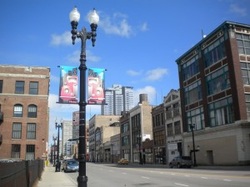
In October 2011, the City of Chicago designated Motor Row as an entertainment district (the only district with such designation in the City), showing the City’s confidence in and commitment to the development of the area. As a result of this important zoning designation, there will be a streamlined approval process for building permits, licensing, noise ordinances, signage and more for developers in the Motor Row District.
Motor Row is also designated as a Chicago Landmark District, one of only fifty landmark districts located within the city. While the landmark designation provides legal protection to the area, it more importantly signifies that Motor Row is regarded as a critical part of the City’s history. It also highlights the distinctive theme and high degree of architectural significance found throughout the Motor Row corridor.
The City recently completed a street beautification initiative in the Motor Row District, putting into place the necessary infrastructure upgrades and decorative elements. Also, since designating Motor Row as an entertainment district, the City has even more plans to beautify the area and make it pedestrian-friendly, adding landscape and distinctive signage. Further, the City has torn down vertical lower-income housing formerly located in the adjacent neighborhood. All this is evidence of the City’s continued commitment to making Motor Row a safe, clean, and desirable destination area
Also announced in October 2011 was the City’s approval of the Chicago Transit Authority’s plan to build a new $55 million Green Line train stop at 23rd and State Streets, which will serve Motor Row, McCormick Place and the South Loop. This new Green Line stop will also play an integral role in connecting these areas to both Midway and O’Hare airports. The funding for construction of the new train station has been approved and is scheduled to begin in June 2013. The City of Chicago has also approved $5.5 million worth of improvements to the Motor Row District streetscape plan which is scheduled to begin in July 2013.
The South Loop has recently seen a surge of renovated and new condominium structures throughout the area. The South Loop also features many bars, restaurants, and attractions that continue to draw residents and visitors to the area. (City of Chicago http://www.cityofchicago.org/content/dam/city/depts/dcd/tif/T_072_BSB_Holdings_CDC.pdf)
Motor Row is also designated as a Chicago Landmark District, one of only fifty landmark districts located within the city. While the landmark designation provides legal protection to the area, it more importantly signifies that Motor Row is regarded as a critical part of the City’s history. It also highlights the distinctive theme and high degree of architectural significance found throughout the Motor Row corridor.
The City recently completed a street beautification initiative in the Motor Row District, putting into place the necessary infrastructure upgrades and decorative elements. Also, since designating Motor Row as an entertainment district, the City has even more plans to beautify the area and make it pedestrian-friendly, adding landscape and distinctive signage. Further, the City has torn down vertical lower-income housing formerly located in the adjacent neighborhood. All this is evidence of the City’s continued commitment to making Motor Row a safe, clean, and desirable destination area
Also announced in October 2011 was the City’s approval of the Chicago Transit Authority’s plan to build a new $55 million Green Line train stop at 23rd and State Streets, which will serve Motor Row, McCormick Place and the South Loop. This new Green Line stop will also play an integral role in connecting these areas to both Midway and O’Hare airports. The funding for construction of the new train station has been approved and is scheduled to begin in June 2013. The City of Chicago has also approved $5.5 million worth of improvements to the Motor Row District streetscape plan which is scheduled to begin in July 2013.
The South Loop has recently seen a surge of renovated and new condominium structures throughout the area. The South Loop also features many bars, restaurants, and attractions that continue to draw residents and visitors to the area. (City of Chicago http://www.cityofchicago.org/content/dam/city/depts/dcd/tif/T_072_BSB_Holdings_CDC.pdf)

